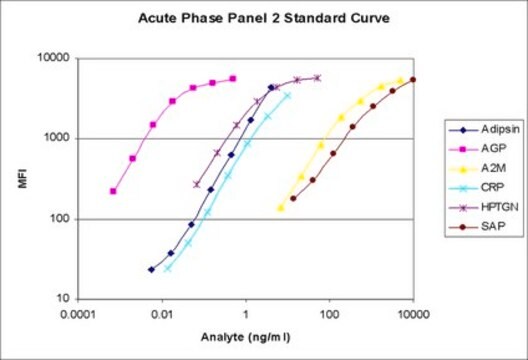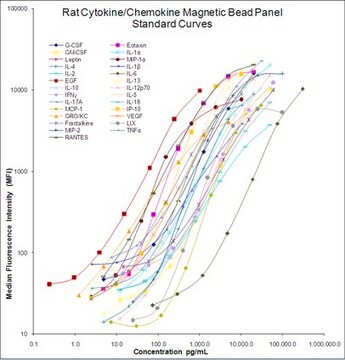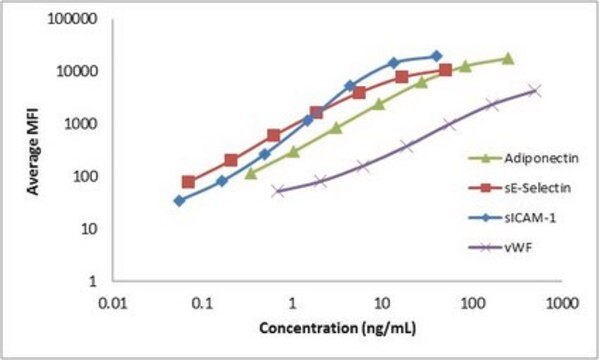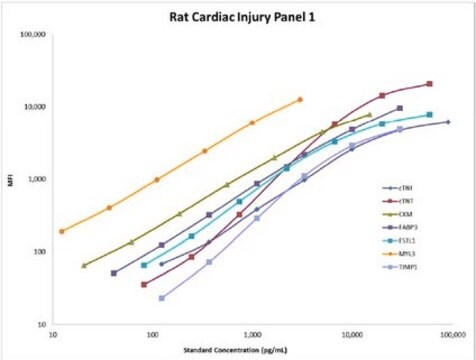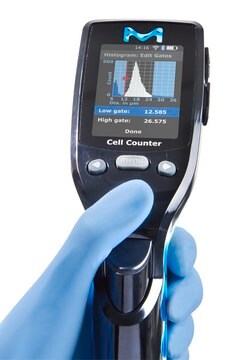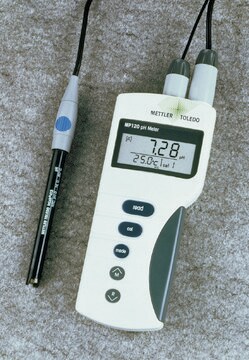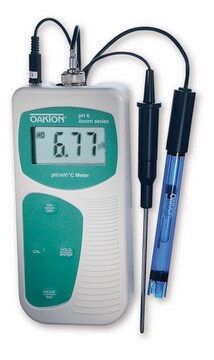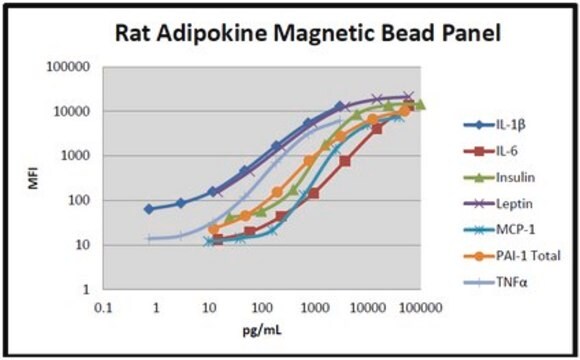RV1MAG-26K
MILLIPLEX® Rat Vascular Injury Magnetic Bead Panel 1 - Toxicity Multiplex Assay
The analytes available for this multiplex kit are: Caveolin-1, CINC-1/GRO/KC, CTGF (Connective Tissue Growth Factor), IL-6, MCP-1, PAI-1 (total), TIMP-1, TNFα, VEGF.
Synonim(y):
Luminex® Rat Vascular Injury Panel, Millipore Rat Vascualr Injury Panel, Rat Vascular Injury Multiplex Assay
About This Item
Polecane produkty
Poziom jakości
reaktywność gatunkowa
rat
producent / nazwa handlowa
Milliplex®
assay range
accuracy: 97-108%
intra-assay cv: <10%
standard curve range: 0.1-100 ng/mL
(CINC-1/GRO/KC, IL-6, MCP-1, PAI-1 (total))
standard curve range: 0.1-15 ng/mL
(VEGF)
standard curve range: 0.1-20 ng/mL
(TNFα)
standard curve range: 0.2-150 ng/mL
(TIMP-1)
standard curve range: 0.3-200 ng/mL
(CTGF)
standard curve range: 1.4-1,000 ng/mL
(Caveolin-1)
inter-assay cv: <10%
(All other analytes)
inter-assay cv: <15%
(CINC-1/GRO/KC, PAI-1 (total), TIMP-1, TNFα)
inter-assay cv: <20%
(Caveolin-1)
metody
multiplexing: suitable
metoda wykrywania
fluorometric (Luminex xMAP)
Warunki transportu
wet ice
Opis ogólny
The MILLIPLEX® Rat Vascular Injury Bead Panel contains all the components necessary to measure the following 9 biomarkers in any combination using Luminex® xMAP® technology: Caveolin-1, CINC-1/GRO/KC, CTGF (Connective Tissue Growth Factor), IL-6, MCP-1, PAI-1 (total), TIMP-1, TNFα, VEGF. The kit uses a 96-well format, contains a lyophilized standard cocktail, 2 quality controls and can measure up to 38 serum or plasma samples in duplicate.
Panel Type: Toxicity
Specyficzność
Zastosowanie
- Analytes: Caveolin-1, CINC-1/GRO/KC, CTGF (Connective Tissue Growth Factor), IL-6, MCP-1, PAI-1 (total), TIMP-1, TNF-α, VEGF
- Recommended Sample type: serum and plasma
- Recommended Sample dilution: 1:4 in kit Serum Matrix
- Assay Run Time: Overnight
- Research Category: Toxicity
Cechy i korzyści
Opakowanie
Przechowywanie i stabilność
Inne uwagi
Informacje prawne
Oświadczenie o zrzeczeniu się odpowiedzialności
Hasło ostrzegawcze
Danger
Zwroty wskazujące rodzaj zagrożenia
Zwroty wskazujące środki ostrożności
Klasyfikacja zagrożeń
Acute Tox. 3 Dermal - Acute Tox. 4 Inhalation - Acute Tox. 4 Oral - Aquatic Chronic 2 - Eye Dam. 1 - Skin Sens. 1 - STOT RE 2
Organy docelowe
Respiratory Tract
Kod klasy składowania
6.1C - Combustible acute toxic Cat.3 / toxic compounds or compounds which causing chronic effects
Certyfikaty analizy (CoA)
Poszukaj Certyfikaty analizy (CoA), wpisując numer partii/serii produktów. Numery serii i partii można znaleźć na etykiecie produktu po słowach „seria” lub „partia”.
Masz już ten produkt?
Dokumenty związane z niedawno zakupionymi produktami zostały zamieszczone w Bibliotece dokumentów.
Nasz zespół naukowców ma doświadczenie we wszystkich obszarach badań, w tym w naukach przyrodniczych, materiałoznawstwie, syntezie chemicznej, chromatografii, analityce i wielu innych dziedzinach.
Skontaktuj się z zespołem ds. pomocy technicznej